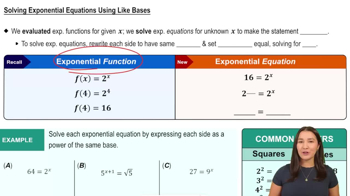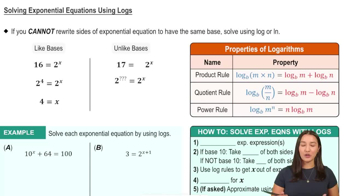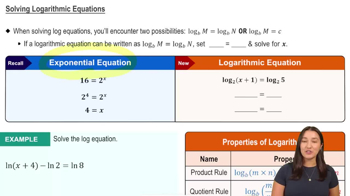Table of contents
- 0. Functions7h 52m
- Introduction to Functions16m
- Piecewise Functions10m
- Properties of Functions9m
- Common Functions1h 8m
- Transformations5m
- Combining Functions27m
- Exponent rules32m
- Exponential Functions28m
- Logarithmic Functions24m
- Properties of Logarithms34m
- Exponential & Logarithmic Equations35m
- Introduction to Trigonometric Functions38m
- Graphs of Trigonometric Functions44m
- Trigonometric Identities47m
- Inverse Trigonometric Functions48m
- 1. Limits and Continuity2h 2m
- 2. Intro to Derivatives1h 33m
- 3. Techniques of Differentiation3h 18m
- 4. Applications of Derivatives2h 38m
- 5. Graphical Applications of Derivatives6h 2m
- 6. Derivatives of Inverse, Exponential, & Logarithmic Functions2h 37m
- 7. Antiderivatives & Indefinite Integrals1h 26m
0. Functions
Exponential & Logarithmic Equations
Problem 1.11
Textbook Question
Sketch the graph of the inverse of ƒ. <IMAGE>
 Verified step by step guidance
Verified step by step guidance1
Step 1: Understand the concept of an inverse function. The inverse of a function \( f \), denoted as \( f^{-1} \), is a function that 'reverses' the effect of \( f \). For a function to have an inverse, it must be one-to-one (bijective).
Step 2: Identify the domain and range of the original function \( f \). The domain of \( f \) becomes the range of \( f^{-1} \), and the range of \( f \) becomes the domain of \( f^{-1} \).
Step 3: Reflect the graph of \( f \) across the line \( y = x \). This reflection will give you the graph of \( f^{-1} \). Each point \((a, b)\) on the graph of \( f \) corresponds to a point \((b, a)\) on the graph of \( f^{-1} \).
Step 4: Verify that the reflected graph is a function. Ensure that the graph of \( f^{-1} \) passes the vertical line test, which confirms that it is a valid function.
Step 5: Label the axes and key points on the graph of \( f^{-1} \) to clearly indicate the transformation from the original function \( f \).
Recommended similar problem, with video answer:
 Verified Solution
Verified SolutionThis video solution was recommended by our tutors as helpful for the problem above
Video duration:
5mPlay a video:
Was this helpful?

 4:46m
4:46mWatch next
Master Solving Exponential Equations Using Like Bases with a bite sized video explanation from Callie
Start learningRelated Videos
Related Practice




